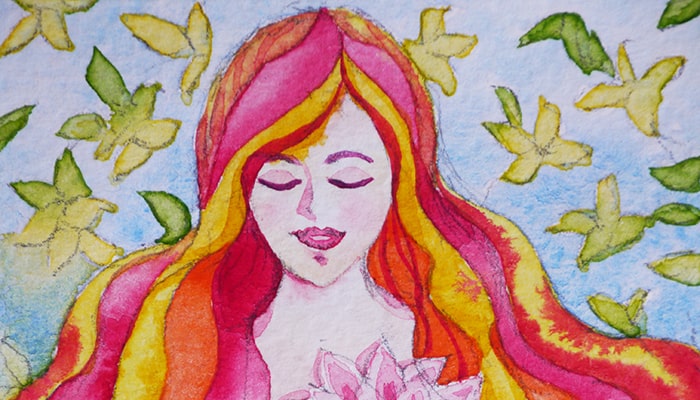Category: Blog
Blog: The Wisdom of Black Elk
By Isa Gucciardi, Ph.D.
As a child, the indigenous peoples of North America fascinated me. I lived in northern Mexico, home to a Native American people known as the Huichol. Their relationship to the land, kindness, and gentle strength spoke to me. The way they moved in their world seemed in perfect balance. Whenever I could sneak away from my parents, I would spend time with the locals who taught me about horses, plants, and generosity of spirit. Inspired by these friends, I made a study of all the great Native American chiefs and shamans by reading everything I could find on them in the local library. Red Cloud, Cochise, and Crazy Horse were all people I admired for the way they maintained their dignity and inspired their people despite overwhelming odds. One of my favorite of these leaders was the visionary Sioux medicine man, Black Elk.
Blog: The Sacred Land of Menla: A Season of Ceremony
By Isa Gucciardi, Ph.D.
The fall season is upon us and I am reminded how, for many people, now and in times past, this is a time for gathering together to mark the change of light and to give thanks. The act of ceremony brings us into deeper communion with ourselves, with others, and the natural world around us. To mark this season of the fall equinox, I gathered with a group of students for a drum circle in the sanctuary of the Sacred Stream Center. When the drumming began, the late afternoon light filled the wooden rafters that arched over us. It streamed in through the century-old stained glass, dimming bit by bit in much the same way the days will shorten and the light will continue to dim until we meet again at the winter solstice drum circle, when the cycle will reverse and the days will grow longer once more.
Blog: Creating a Value System for your Child
By Isa Gucciardi, Ph.D.
When you are a parent, it’s necessary to understand your own value system. As a parent, your responsibility is to guide your child to the best of your ability. One way you can guide them is by knowing what your values are and teaching them to your child by example. If you don’t know what your values are and what values you want to impart to your child, it is important to sit down and figure them out.
Blog: Compassion, the US Open, and a Blueprint for Saving the World
By Laura Chandler
Something remarkable happened at the US Open this year when Naomi Osaka (currently ranked #1 in the world in women’s tennis) defeated 15-year-old tennis sensation, Coco Gauff in the third round. Naomi consoled a crying Coco on the sidelines. She told her it was alright to cry, then invited her to stay and join her for the post-match on court interview where she praised Coco for her talent. This display of sportsmanship was not only kind; it illustrated something even more significant about human nature and our ability to be strong and compassionate, simultaneously.
Blog: Overcoming Denial: Part 3
By Denise Colby
It goes without saying that what makes doubt and denial so good at keeping you shackled is that you don’t know what you don’t know. If you can’t see it, how on earth do you begin to heal? There are many ways that truth begins to surface within us, but this is one of the places where a consciousness practice can be quite helpful. In the first part of this article, we discuss some of the ways in which we become aware that things are not as they seem and all is not well. This section addresses what to do once you have made the commitment to move into the light and live in truth.
Blog: Overcoming Denial: Part 2
By Denise Colby
If we have been in deep denial about some aspect of our experience, the revelation of truth will at first be a painful one. Truth will make its entrance in ways that will seem quite disturbing—intrusive thoughts, nightmares, innocuous interactions producing strong emotions, or a general feeling that one is “not OK.” It is at this juncture that we come to a choice: we can stay in denial and find external reasons to justify our internal experience, numbing and modulating using whatever coping mechanisms we have, or we can claim our internal experience as something uniquely personal and get very curious about it.
There are many roads out of denial, but at some point we will have to choose to validate what our body and reactivity is saying over the story we’ve been telling ourselves. This breaking down of an old story — the acknowledgement that we’ve been telling ourselves a false story our whole lives — provides the crack where the light of truth can finally break through to our awareness.
Blog: Overcoming Denial: Part 1
By Denise Colby
Of all of the defense tactics and cycles of negativity that we get wrapped up in during our human experience, denial is perhaps the hardest to overcome. It’s insidious and manipulative, yet we cling to it fiercely.
We see denial everywhere we look. It is as rampant on the public and cultural scale as it is in our relationships. The external stage, as always, provides a mirror for our own inner relationship to truth. To live in truth, we must examine further the sources, motivations for, and consequences of denial on the inner stage, for it is only through the resolution of our own rejection of truth that we can begin to clearly see and resolve the external falsehoods that abound.
Blog: Aging Gracefully In A Youth Culture
By Laura Chandler
In a recent article in The Atlantic titled, “Your Professional Decline is Coming (Much) Sooner Than You Think” (July 2019), the author, Arthur Brooks, looks for a silver lining as he explores the idea of his own unavoidable decline and the loss of relevance he will suffer in old age. His investigation takes him to different psychological principles, Darwin’s theory of evolution, happiness studies, and ultimately to an Indian guru, Acharya. His question to this master was this: “Many people of achievement suffer as they age, because they lose their abilities, gained over many years of hard work. Is this suffering inescapable, like a cosmic joke on the proud? Or is there a loophole somewhere—a way around the suffering?”
Blog: Personal Responsibility: An Interview with Isa Gucciardi, Ph.D.
Question: How would you define personal responsibility?
Isa: Personal responsibility is a process of becoming more self-aware, understanding your motivations, your intentions, and the effect your actions and thoughts have on you and those around you. It involves a willingness to contemplate the consequences of your emotional responses, and the ability to recognize when those expressions are harmful and when they are beneficial.
Blog: Huna: Aka-Mana Patterns
By Isa Gucciardi, Ph.D.
The idea of Aka and Mana is drawn from Huna, a tradition of knowledge that has been stored in Hawaii for the last thousand years or so. According to its oral history, it was brought to Hawaii for conservation in times of darkness. You can trace the progression of Huna from northern Africa all the way to India and throughout Melanesia. This system of knowledge has become incorporated into certain native practices of Hawaiian Shamanism.
Blog: The Great Feminine: An Excerpt from Return to the Great Mother
By Isa Gucciardi, Ph.D.
The concept of a Great Feminine principle is common to many cultural and religious traditions. The icon of the Great Feminine is viewed in these traditions as the generator and caretaker of life. The images of the Great Feminine vary from tradition to tradition, but the values and qualities of these images are surprisingly consistent. Whatever her form, she is always considered a protector and guardian of life.
Blog: Boundaries: A Case Study
By Isa Gucciardi, Ph.D.
When people come into my office with relationship problems, they do not always realize they’re dealing with boundary issues. Many people think if they’re being treated badly in relationship, they must be doing something wrong. This is generally due to a lack of understanding about boundaries, and this lack of understanding usually stems from a place of unworthiness. The person being mistreated believes they’re flawed in some way, and makes compromises to stay in relationships where they are suffering. Boundary issues almost always arise when a person doesn’t feel lovable, and consequently, they’re willing to do almost anything to get another person’s approval. Because they don’t love themselves, they are dependent on others to be sources of love and validation.
Buddhist Meditation in Depth Hypnosis
By Isa Gucciardi, Ph.D.
Depth Hypnosis is a therapeutic process that blends elements of Shamanism, Buddhism, transpersonal psychology, hypnotherapy, and energy medicine. Buddhism is one of the main engines of Depth Hypnosis, and meditation is one of many tools we use to help clients alter their state of consciousness. Meditation enables clients to shift their focus from their “thinking minds” to their inner experience.















